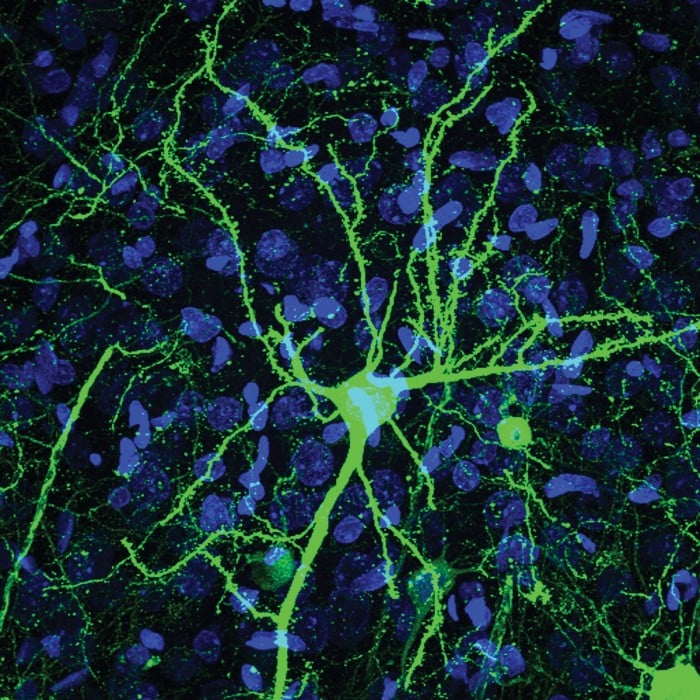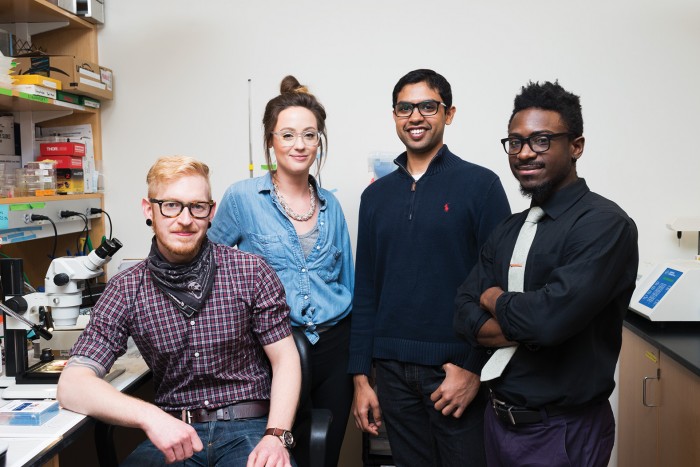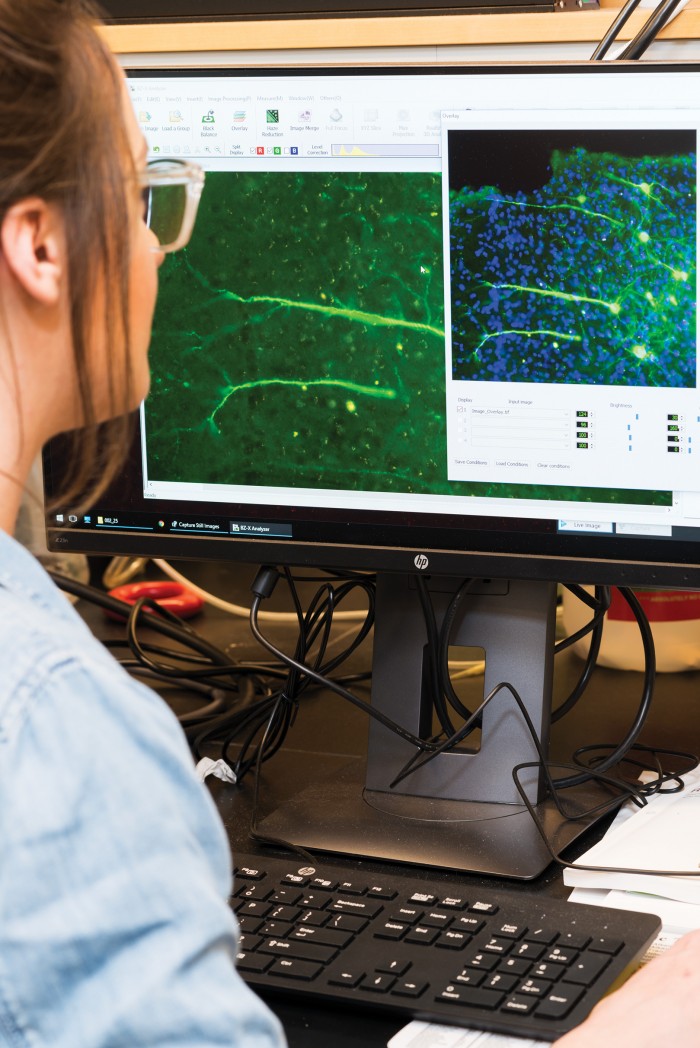How the Brain Seeks Pleasure and Avoids Pain

As a child, Kay Tye was immersed in a life of science. “I grew up in my mom’s lab,” she says. At the age of five or six, she earned 25 cents a box for “restocking” bulk-ordered pipette tips into boxes for sterilization as her mother, an acclaimed biochemist at Cornell University, probed the genetics of yeast. (Tye’s father is a theoretical physicist known for his work on cosmic inflation and superstring theory.)
Today, Tye runs her own neuroscience lab at MIT. Under large black lights reminiscent of a fashion shoot, she and her team at the Picower Institute for Learning and Memory can observe how mice behave when particular brain circuits are turned on or off. Nearby, they can record the mice’s neural activity as the animals move toward a particular stimulus, like sugar water, or away, if they’re crossing a floor that delivers mild electric shocks. Elsewhere, they create brain slices to test in vitro, since these samples retain their physiological activity, even outside the body, for up to eight hours.
Tye has been at the forefront of efforts to pinpoint the sources of anxiety and other emotions in the brain by analyzing how groups of neurons work together in circuits to process information. In particular, her work has contributed to a profound shift in researchers’ understanding of the amygdala, a brain area that has been thought of as central to fear responses: she has found that signaling in the amygdala can in fact reduce anxiety as well as increase it. To gain such insights, she has also made crucial advances in a technique, called optogenetics, that allows researchers to activate or suppress particular neural circuits in lab animals using light. Optogenetics was developed by Stanford neuroscientist and psychiatrist Karl Deisseroth, and it represented a breakthrough in efforts to determine the role of specific parts of the brain. While Tye was working in his laboratory as a postdoc, she demonstrated, for the first time, that it was possible to pinpoint and control specific groups of neurons that were sending signals to specific target neurons.

This fine-grained approach is important because drugs that treat conditions like anxiety currently do not target specific circuits, let alone individual neurons; rather, they operate throughout the brain, which often leads to undesirable side effects. Tye’s research may eventually help open the door to drugs that affect only specific neural circuits, reducing anxiety with fewer side effects.
Such work has earned formal accolades, including a Presidential Early Career Award for Scientists and Engineers from President Obama, a Freedman Prize for neuroscience, and a TR35 award, recognizing outstanding researchers under the age of 35. Tye has also won high praise from others in her field who admire the creative breadth of her ambition. “She’s not afraid to ask the most fundamental questions, the ones most other scientists shy away from,” says Sheena Josselyn of the University of Toronto and the Hospital for Sick Children Research Institute.
The questions she takes on involve emotions and phenomena that loom large in human experience, such as reward-seeking, loneliness, and compulsive overeating. Her goal is to understand their neural basis—to bridge the gap between brain, as understood by neuroscientists, and the mind, as conceived more expansively by psychiatrists, psychologists, and other students of human behavior.
Would-be novelist
Though it might seem as if Tye was born to be a scientist, she says her choice of career was anything but inevitable. In high school, she was ambivalent about science and gravitated instead toward writing; she wrote plays, short stories, and poetry. “In my mind, I was going to be a novelist,” she recalls.
Still, while applying to college, she included MIT on her list, partly to humor her parents, Bik-Kwoon Tye and Henry Tye, both of whom had earned PhDs there in 1974. And when she received an acceptance letter, her father found it hard to disguise his feelings as his eyes welled with tears. “I’d never in my life seen my dad cry,” she says. She decided that she ought to give scientific learning a more dedicated try. She also convinced herself (with parental encouragement) that focusing on the natural world would give her more to write about down the road.
As a freshman at MIT, Tye joined the lab of Suzanne Corkin, who was working with H.M., one of the most famous patients in the history of neuroscience. H.M., whose name was revealed to be Henry Molaison upon his death in 2008, suffered from profound amnesia after a lobotomy to treat seizures; studying his condition allowed researchers to probe the neural underpinnings of memory. One of Tye’s roles in the group was to make H.M. a peanut butter and jelly sandwich for lunch. He would eat it and then, moments later, with crumbs still on his face, ask, “Did we have lunch yet?”

“It made me appreciate that these basic functions, like memory, that are so key to who we are have biological substrates in the brain,” she says. Neuroscience can be intimidating and filled with jargon, she adds. But the experience with H.M., along with an inspiring introductory psychology class taught by Steven Pinker, “made it seem worth it to slog through the all-nighters” to understand the biological mechanisms behind psychological constructs.
Still, after graduation, Tye wanted to make sure she was “looking around,” thinking about who she was and who she wanted to be. So she spent a year backpacking in Australia, where she worked on a farm, lived in a yoga ashram, taught yoga, camped out on the beach, and worked on a novel. She found that writing was “hard and lonely.” She enjoyed teaching yoga but didn’t see it as a satisfying career path.
“I came out of that year surprisingly ready to go to grad school,” she says. Diving back into the academic world, she initially struggled to find a lab that would accept her and almost dropped out after her first year. But she found a mentor in Patricia Janak, who became her advisor, and earned a PhD in neuroscience at the University of California, San Francisco, in 2008.
A surprise in the amygdala
In 2009, Tye joined Deisseroth’s lab at Stanford. Deisseroth had already developed optogenetics, which gave researchers a much more precise way to identify the contributions of individual neurons within a circuit. Along with others in the lab, Tye used optogenetics to probe the connection between two parts of the amygdala, an almond-shaped region that is crucial to anxiety and fear. She first identified neurons in one area (known as the basolateral amygdala) that formed connections to neurons in another amygdalar area (known as the central nucleus) by sending out projections of nerve fibers. When she stimulated those basolateral amygdala neurons, she was able to reduce anxiety in mice. That is, she could cause the animals to spend more time in open spaces and less time cowering to the side. This was surprising, because when researchers stimulated the amygdala as a whole, the mice’s behavior grew more anxious.
At first, everyone asked, “Are you sure you’re using the tool right? What’s going on?” she recalls. But after meticulous validation, in 2011, Tye and the group published their results in Nature, showing that some circuitry within the amygdala helps to calm animals down. This paper also represented a breakthrough in optogenetic technique. For the first time, researchers were able to zero in on and manipulate a specific part of a brain circuit: particular groups of neurons communicating with known target neurons. The technique, known as optogenetic projection-specific manipulation, is now considered one of the key tools of neuroscience.
In 2012, Tye came to MIT as an assistant professor of brain and cognitive sciences at the Picower, continuing her work on anxiety. While setting up her lab, she targeted neurons within the amygdala that seemed to have the opposite effect on mouse anxiety, causing it to increase. These brain cells are also located in the basolateral amygdala, but they send projections to a nearby region known as the ventral hippocampus. When Tye stimulated this circuit using optogenetics, the mice avoided open spaces, apparently suffering from anxiety. (When she inhibited the connections from forming, the animals hung out in the open again, their anxiety seemingly alleviated.) Tye proposed that neighboring neurons in the amygdala can have opposite effects on animals’ behavior, depending on the targets to which they send signals.

Threats and rewards
At the time, most researchers studying the amygdala still tended to focus mainly on its role in fear. Yet Tye suspected that activity in this part of the brain might encode a stimulus as either rewarding or threatening, good or bad, helping individuals decide how to respond. “There are many stimuli we encounter in our daily lives that are ambiguous,” says Conor Liston of the Brain and Mind Research Institute at Weill Cornell. “A social interaction, for example, can be either threatening or rewarding, and we need brain circuits devoted to differentiating which is which.”
By looking at the relative strength of the currents passing through two glutamate receptors known to indicate synaptic strength, Tye discovered that different neural connections in mice were reinforced depending on whether a particular stimulus was linked to a reward or a threat. When mice learned to associate a sound with a treat of sugar, she found stronger synaptic input to the neurons in the basolateral amygdala that were sending information to the nucleus accumbens, which is part of the brain’s reward circuitry. On the other hand, when mice learned to associate the sound with mild electric shocks to their feet, input signals grew stronger in circuits leading from the basolateral amygdala to the centromedial amygdala, which is involved in pain and fear. In addition, she demonstrated a trade-off: when one of these circuits grew more active, the other grew less so. In other words, she had found how the brain encodes information that allows mice to differentiate between stimuli that are rewarding and those that are potentially harmful. The results were published in Nature in 2015.
In recent work, Tye also probed the circuitry involved in making split-second decisions when both threatening and rewarding cues are present at the same time. She and her team focused this time on connections between the amygdala and the prefrontal cortex, an area responsible for higher-order thinking. (Specifically, they examined interactions between the basolateral amygdala and the prelimbic medial prefrontal cortex.) Using optogenetics and other techniques, they showed that this circuitry was active when the animals were simultaneously exposed to a potential sugar treat and a potential electric shock and had to make a decision about how to behave. Her results, which appeared in April in Nature Neuroscience, help illuminate how animals figure out what to do in the face of complex and sometimes contradictory cues.

Cravings and compulsions
As a graduate student, Tye had worked with researchers focused on addiction, but she was more interested in natural rewards, like sugar, than in substances that are regularly abused. In 2012, New York City mayor Michael Bloomberg announced a plan to limit the portion size of sodas sold in movie theaters, stadiums, and fast-food restaurants. Tye found herself wondering what exactly, at a brain level, causes people to crave sugary treats, above and beyond the normal drive to satisfy hunger.
So she delved into the neural circuitry. In a paper published in 2015 in Cell, she and her team focused on neurons in the lateral hypothalamus (LH), a brain area involved in drives like hunger, and studied their projections into another region, called the ventral tegmental area (VTA), known to play a role in both motivation and addiction. Using optogenetics, she and her team showed that turning on specific LH-VTA connections caused the mice to gorge on sugar, while turning them off reduced the compulsive overeating.
On her desktop, Tye loads a video demonstration featuring a mouse with a cable for light transmission attached to its brain. The video shows the mouse moving around, casually at first. Then, when the laser light is turned on to activate specific neurons in the LH-VTA circuit, the animal becomes frantic, running and licking the floor. Soon after, it brings its empty paws up to its mouth and does a pantomime of tasting and nibbling. “It engages in this complicated motor sequence and pretends to eat, which is crazy because there’s no food,” says Tye. In other words, turning the circuit on causes the animal to behave compulsively. Turning it off has the opposite effect.
Crucially, though, while switching off this circuit prevents compulsive behavior, it does not affect normal eating. That is, it is possible to define a brain-based difference between at least some healthy and unhealthy drives to eat. This suggests that it might be possible to develop targeted drugs or even some form of biofeedback that might someday help people reduce unhealthy cravings without blocking ordinary hunger.
Another recent finding, about loneliness, arose serendipitously from a project that postdoc Gillian Matthews had begun as a graduate student at Imperial College London with Mark Ungless. Matthews noticed that mice that had been isolated for 24 hours during experiments displayed stronger neural signaling in the brain’s dorsal raphe nucleus, which participates in reward signaling—and actively sought out the company of other mice. After she moved to Tye’s lab at MIT, Matthews and Tye developed the theory that the animals were craving interaction. In further experiments, they used optogenetics to turn off the signaling pathway in the dorsal raphe nucleus. Mice subjected to this treatment did not seem to seek out additional social interaction following time by themselves.
Ultimately, Tye hopes that she and her team can speak to fundamental human questions, like why some people prefer to spend more time alone while others crave greater social contact.
A lab without drama
Though Tye’s lab is interested in the origins of phenomena like fear and compulsion, it is notable for its own lack of tension and conflict. Stephen Allsop, a postdoc who has worked with her for five years (several of which were spent as a graduate student), says that she stresses close collaboration among team members and oversees an upbeat, supportive culture: “It’s amazing how little drama we have in this lab.”
“Along with scientific integrity, I make the positive, collaborative, open culture of my research group—and the happiness of the individuals within it—my top priority,” says Tye. “Scientific excellence is a close second.” Strong relationships with professors and mentors are part of the draw of science, she adds.
Indeed, she says, they are second only to the bonds between parents and children. In 2013, Tye and her husband, Jim Wagner, a software developer, had a daughter, Keeva, who has already accompanied her to conferences around the world. Their son, Jet, was born last year. And the children have found a place in her lab, much as she found a niche in her mother’s (though they have yet to earn paid positions). As she told Nature when Keeva was still an infant: “If my daughter all of a sudden needs to be picked up, I bring her to my lab meeting or meet with people while I bounce her. If she has a total meltdown, then sometimes I have to bail and follow up later.”
But while she may be easygoing as a parent and a lab leader, Tye finds plenty of drama in neuroscience itself, and she keeps returning to its central questions because they are so enticing. Though she says she reads fewer novels now than she used to, she still seems compelled by the kinds of mysteries a writer might probe: Why does a hero set out on a journey? Why does the chatter in his or her head go awry and lead to gloomy soliloquizing or anxious self-sabotage? Like a novelist, she exhibits tremendous creative breadth. “There is something special about science,” she says. “Your new work is based on what you did previously. And if you’re lucky, you can help shape the future.”
Keep Reading
Most Popular
Large language models can do jaw-dropping things. But nobody knows exactly why.
And that's a problem. Figuring it out is one of the biggest scientific puzzles of our time and a crucial step towards controlling more powerful future models.
How scientists traced a mysterious covid case back to six toilets
When wastewater surveillance turns into a hunt for a single infected individual, the ethics get tricky.
The problem with plug-in hybrids? Their drivers.
Plug-in hybrids are often sold as a transition to EVs, but new data from Europe shows we’re still underestimating the emissions they produce.
Stay connected
Get the latest updates from
MIT Technology Review
Discover special offers, top stories, upcoming events, and more.